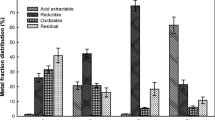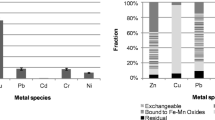Abstract
In this study, the feasibility of an ex situ electrokinetic (EK) process combined with pre-oxidation using hydrogen peroxide (H2O2) and pre-washing using ethylenediaminetetraacetic acid (EDTA) was investigated in enhancing the extraction of Cu, Pb, and Zn from actual dredged harbor sediment. H2O2 pre-oxidation led to a change in the fractionation of Cu bound to organic matter and the sulfide fraction in the Fe-Mn oxides to the exchangeable fraction, but was not effective at removing metals. In contrast, EDTA pre-washing changed the Fe-Mn oxide-bound fractions of Cu and Pb into easily extractable fractions; 20.1, 27.5, and 32.8 % of Cu, Pb, and Zn were removed, respectively. During EK treatment, metals were transported toward the anode by electromigration of negatively charged complexes such as metal-EDTA and metal-citrate. However, EK treatment did not significantly enhance the removal of metals because metals accumulated near the anodic region with an increase in the exchangeable fraction due to the short EK operating duration and low voltage gradient. Therefore, it is necessary to extend the EK operating duration and/or increase the voltage gradient for effective transportation and removal of metals from sediment.






Similar content being viewed by others
References
Acar YB, Alshawabkeh AN (1993) Principles of electrokinetic remediation. Environ Sci Technol 27:2638–2647
Acar YB, Gale RJ, Alshawabkeh AN, Marks RE, Puppala S, Bricka M, Parker R (1995) Electrokinetic remediation—basics and technology status. J Hazard Mater 40:117–137
Al-Hamdan AZ, Reddy KR (2008) Transient behavior of heavy metals in soils during electrokinetic remediation. Chemosphere 71:860–871
Altaee A, Smith R, Mikhalovsky S (2008) The feasibility of decontamination of reduced saline sediments from copper using the electrokinetic process. J Environ Manag 88:1611–1618
Baek K, Kim DH, Park SW, Ryu BG, Bajargal T, Yang JS (2009) Electrolyte conditioning-enhanced electrokinetic remediation of arsenic-contaminated mine tailing. J Hazard Mater 161:457–462
Colacicco A, De Gioannis G, Muntoni A, Pettinao E, Polettini A, Pomi R (2010) Enhanced electrokinetic treatment of marine sediments contaminated by heavy metals and PAHs. Chemosphere 81:46–56
Di Palma L, Gonzini O, Mecozzi R (2011) Use of different chelating agents for heavy metal extraction from contaminated harbour sediment. Chem Ecol 27:97–106
Hwang B-R, Kim E-J, Yang J-S, Baek K (2014) Extractive and oxidative removal of copper bound to humic acid in soil. Environ Sci Pollut Res (in press)
Jensen PE, Ottosen LM, Ferreira C, Villumsen A (2006a) Kinetics of electrodialytic extraction of Pb and soil cations from a slurry of contaminated soil fines. J Hazard Mater 138:493–499
Jensen PE, Ottosen LM, Pedersen AJ (2006b) Speciation of Pb in industrially polluted soils. Water Air Soil Pollut 170:359–382
Jeon E-K, Jung J-M, Kim W-S, Ko S-H, Baek K (2014) In situ electrokinetic remediation of As-, Cu-, and Pb-contaminated paddy soil using hexagonal electrode configuration: a full scale study. Environ Sci Pollut Res (in press)
Jo S-U, Kim D-H, Yang J-S, Baek K (2012) Pulse-enhanced electrokinetic restoration of sulfate-containing saline greenhouse soil. Electrochim Acta 86:57–62
Kim DH, Ryu BG, Park SW, Seo CI, Baek K (2009) Electrokinetic remediation of Zn and Ni-contaminated soil. J Hazard Mater 165:501–505
Kim BK, Baek K, Ko SH, Yang JW (2011) Research and field experiences on electrokinetic remediation in South Korea. Sep Purif Technol 79:116–123
Kim WS, Park GY, Kim DH, Jung HB, Ko SH, Baek K (2012) In situ field scale electrokinetic remediation of multi-metals contaminated paddy soil: Influence of electrode configuration. Electrochim Acta 86:89–95
Kirkelund GM, Ottosen LM, Villumsen A (2009) Electrodialytic remediation of harbour sediment in suspension—evaluation of effects induced by changes in stirring velocity and current density on heavy metal removal and pH. J Hazard Mater 169:685–690
Micic S, Shang JQ, Lo KY (2002) Electrokinetic strengthening of marine clay adjacent to offshore foundations. Int J Offshore Polar 12:64–73
Morel F, Hering JG (1993) Principles and applications of aquatic chemistry. Wiley-Interscience, New Jersey
Mulligan CN, Yong RN, Gibbs BF (2001) An evaluation of technologies for the heavy metal remediation of dredged sediments. J Hazard Mater 85:145–163
Nystroem GM, Pedersen AJ, Ottosen LM, Villumsen A (2006) The use of desorbing agents in electrodialytic remediation of harbour sediment. Sci Total Environ 357:25–37
Ottosen LM, Christensen IV (2012) Electrokinetic desalination of sandstones for NaCl removal—test of different clay poultices at the electrodes. Electrochim acta
Ottosen LM, Pedersen AJ, Ribeiro AB, Hansen HK (2005) Case study on the strategy and application of enhancement solutions to improve remediation of soils contaminated with Cu, Pb and Zn by means of electrodialysis. Eng Geol 77:317–329
Park SW, Lee JY, Yang JS, Kim YJ, Baek K (2009) Electrokinetic remediation of contaminated soil with waste-lubricant oils and zinc. J Hazard Mater 169:1168–1172
Peng JF, Song YH, Yuan P, Cui XY, Qiu GL (2009) The remediation of heavy metals contaminated sediment. J Hazard Mater 161:633–640
Polettini A, Pomi R, Rolle E, Ceremigna D, De Propris L, Gabellini M, Tornato A (2006) A kinetic study of chelant-assisted remediation of contaminated dredged sediment. J Hazard Mater 137:1458–1465
Quevauviller P, Rauret G, LopezSanchez JF, Rubio R, Ure A, Muntau H (1997) Certification of trace metal extractable contents in a sediment reference material (CRM 601) following a three-step sequential extraction procedure. Sci Total Environ 205:223–234
Rauret G, Lopez-Sanchez JF, Sahuquillo A, Rubio R, Davidson C, Ure A, Quevauviller P (1999) Improvement of the BCR three step sequential extraction procedure prior to the certification of new sediment and soil reference materials. J Environ Monitor 1:57–61
Rozas F, Castellote M (2012) Electrokinetic remediation of dredged sediments polluted with heavy metals with different enhancing electrolytes. Electrochim Acta 86:102–109
Ryu BG, Park GY, Yang JW, Baek K (2011) Electrolyte conditioning for electrokinetic remediation of As, Cu, and Pb-contaminated soil. Sep Purif Technol 79:170–176
Stietiya MH, Wang JJ (2011) Effect of organic matter oxidation on the fractionation of copper, zinc, lead, and arsenic in sewage sludge and amended soils. J Environ Qual 40:1162–1171
Sun B, Zhao F, Lombi E, McGrath S (2001) Leaching of heavy metals from contaminated soils using EDTA. Environ Pollut 113:111–120
Thoming J, Kliem BK, Ottosen LM (2000) Electrochemically enhanced oxidation reactions in sandy soil polluted with mercury. Sci Total Environ 261:137–147
USEPA (1986) Test methods for evaluating solid waste, physical/chemical methods. SW-846 National Technical Information Service (NTIS), Port Royal Road Springfield
Yoo J-C, Lee C-D, Yang J-S, Baek K (2013) Extraction characteristics of heavy metals from marine sediments. Chem Eng J 228:688–699
Yuan C, Weng CH (2006) Electrokinetic enhancement removal of heavy metals from industrial wastewater sludge. Chemosphere 65:88–96
Acknowledgments
This work was supported by KEITI through GAIA project.
Author information
Authors and Affiliations
Corresponding author
Additional information
Responsible editor: Philippe Garrigues
Rights and permissions
About this article
Cite this article
Yoo, JC., Yang, JS., Jeon, EK. et al. Enhanced-electrokinetic extraction of heavy metals from dredged harbor sediment. Environ Sci Pollut Res 22, 9912–9921 (2015). https://doi.org/10.1007/s11356-015-4155-x
Received:
Accepted:
Published:
Issue Date:
DOI: https://doi.org/10.1007/s11356-015-4155-x




